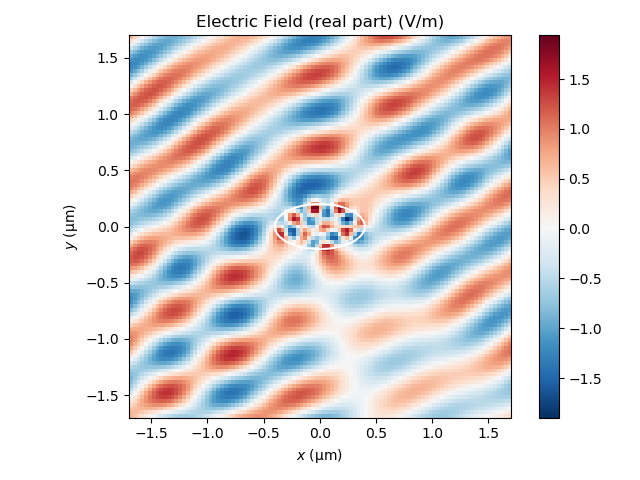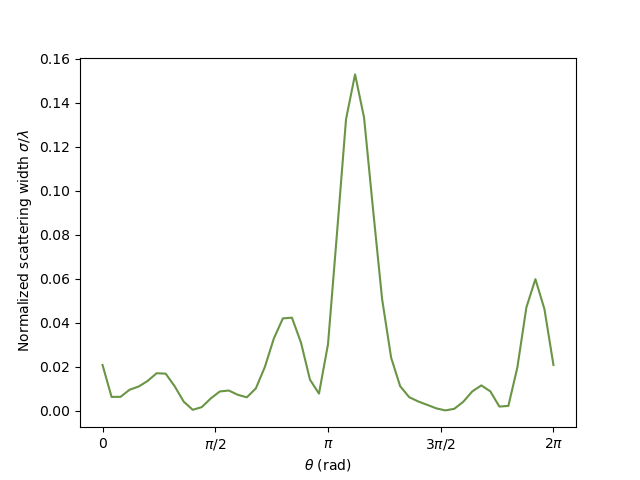Note
Click here to download the full example code or to run this example in your browser via Binder
Simulating diffraction by an object in 2D¶
Finite element simulation of the diffraction by an object illuminated by a plane wave or a line source. Calculation of scattering width and getting the field maps.
import numpy as np
import matplotlib.pyplot as plt
from pytheas import Scatt2D
plt.ion()
pi = np.pi
Then we need to instanciate the class Scatt2D:
fem = Scatt2D()
fem.rm_tmp_dir()
# We define first the opto-geometric parameters:
mum = 1 #: flt: the scale of the problem (here micrometers)
fem.lambda0 = 0.6 * mum #: flt: incident wavelength
fem.pola = "TE" #: str: polarization (TE or TM)
fem.theta_deg = 30.0 # 0: coming from top (y>0)
fem.hx_des = 1.0 * mum #: flt: x thickness box
fem.hy_des = 1.0 * mum #: flt: y thickness box
fem.h_pml = fem.lambda0 #: flt: thickness pml
fem.space2pml_L, fem.space2pml_R = fem.lambda0 * 2, fem.lambda0 * 2
fem.space2pml_T, fem.space2pml_B = fem.lambda0 * 2, fem.lambda0 * 2
fem.eps_des = 1 #: flt: permittivity design box
fem.eps_host = 1.0
fem.eps_incl = 11.0 - 1e-2 * 1j
#: mesh parameters, correspond to a mesh size of lambda_mesh/(n*parmesh),
#: where n is the refractive index of the medium
fem.lambda_mesh = 0.6 * mum #: flt: incident wavelength
fem.parmesh_des = 10
fem.parmesh_incl = 10
fem.parmesh = 10
fem.parmesh_pml = fem.parmesh * 2 / 3
fem.Nix = 101
fem.Niy = 101
Here we define an ellipsoidal rod as the scatterer:
def ellipse(Rinclx, Rincly, rot_incl, x0, y0):
c, s = np.cos(rot_incl), np.sin(rot_incl)
Rot = np.array([[c, -s], [s, c]])
nt = 360
theta = np.linspace(-pi, pi, nt)
x = Rinclx * np.sin(theta)
y = Rincly * np.cos(theta)
x, y = np.linalg.linalg.dot(Rot, np.array([x, y]))
points = x + x0, y + y0
return points
rod = ellipse(0.4 * mum, 0.2 * mum, 0, 0, 0)
fem.inclusion_flag = True
Initialize, build the scatterer, mesh and compute the solution:
fem.initialize()
fem.make_inclusion(rod)
fem.make_mesh()
fem.compute_solution()
Get the electric field and plot it:
fem.postpro_fields()
u_tot = fem.get_field_map("u_tot.txt")
fig, ax = plt.subplots()
E = u_tot.real
plt.imshow(E, cmap="RdBu_r", extent=(fem.domX_L, fem.domX_R, fem.domY_B, fem.domY_T))
plt.plot(rod[0], rod[1], "w")
plt.xlabel(r"$x$ ($\rm \mu$m)")
plt.ylabel(r"$y$ ($\rm \mu$m)")
plt.title(r"Electric Field (real part) (V/m)")
plt.colorbar()
plt.tight_layout()

Do a near to far field transform and get the normalized scattering width:
ff = fem.postpro_fields_n2f()
theta = np.linspace(0, 2 * pi, 51)
scs = fem.normalized_scs(ff, theta)
fig, ax = plt.subplots()
plt.plot(theta / pi, scs, "-", c="#699545")
plt.xlabel(r"$\theta$ (rad)")
plt.ylabel(r" Normalized scattering width $\sigma/\lambda$")
ax.xaxis.set_ticks([0, 0.5, 1, 1.5, 2])
ax.xaxis.set_ticklabels(["0", "$\pi/2$", "$\pi$", "$3\pi/2$", "$2\pi$"])
scs_integ = np.trapz(scs, theta) / (2 * pi)
print("Normalized SCS", scs_integ)

Out:
Normalized SCS 0.02572717419074843
Total running time of the script: ( 0 minutes 15.999 seconds)
Estimated memory usage: 16 MB
